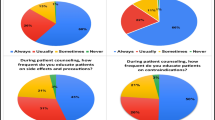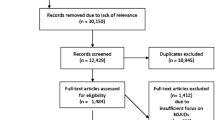Abstract
Background There is a high incidence of adverse effects from non-steroidal antiinflammatory drugs (NSAIDs) in Thailand, but patients’ perceptions and knowledge of NSAID risks is unknown. Objective This study aims to assess patients’ perceptions and knowledge of NSAID risks and factors affecting them. Setting University hospital in North-East of Thailand. Method A Cross-sectional study conducted over 4 months, using a self-administered questionnaire. Patients prescribed NSAIDs for at least one month duration from orthopaedic clinic were recruited using systematic random sampling. Main outcome measure Patients’ perceptions on NSAID risks, knowledge on risk factors, and their associated factors. Results A total of 474 questionnaires were assessed. Overall perceptions of risks was low (scoring below five on a 0–10 visual analogue scale), with risks associated with the renal system scoring highest. Perceived risk of gastrointestinal problems differed between patients using non-selective and selective NSAIDs (3.47 ± 2.75 vs 2.06 ± 2.98; P < 0.001). Receiving side effect information from a health professional was associated with higher risk perception. Most patients (80 %) identified high doses, renal disease and gastrointestinal ulcer increased risks of NSAIDs, but fewer than half recognized that use in the elderly, multiple NSAID use, drinking, hypertension and cardiovascular disease also increased risk of adverse events. Having underlying diseases and receiving side effect information were associated with 1.6–2.0 fold increased knowledge of NSAID risks. Conclusion Perceptions and knowledge concerning NSAID risks was generally low in Thai patients, but higher in those who had received side effect information. Risk-related information should be widely provided, especially in high-risk patients.

Similar content being viewed by others
References
Vonkeman HE, van de Laar MA. Nonsteroidal anti-inflammatory drugs: adverse effects and their prevention. Semin Arthritis Rheum. 2010;39:294–312.
Yu A, Devine CA, Kasdin RG, Orizondo M, Perdomo W, Davis AM, et al. Pain management among Dominican patients with advanced osteoarthritis: a qualitative study. BMC Musculoskelet Disord. 2016;17:211.
Shankar PR, Pai R, Dubey AK, Upadhyay DK. Prescribing patterns in the orthopaedics outpatient department in a teaching hospital in Pokhara, western Nepal. Kathmandu Univ Med J (KUMJ). 2007;5:16–21.
Lee SH, Han CD, Yang IH, Ha CW. Prescription pattern of NSAIDs and the prevalence of NSAID-induced gastrointestinal risk factors of orthopaedic patients in clinical practice in Korea. J Korean Med Sci. 2011;26:561–7.
Wehling M. Non-steroidal anti-inflammatory drug use in chronic pain conditions with special emphasis on the elderly and patients with relevant comorbidities: management and mitigation of risks and adverse effects. Eur J Clin Pharmacol. 2014;70:1159–72.
Zandman-Goddard G, Langevitz P. The lack of awareness of the Israeli population regarding gastrointestinal complications from non-steroidal anti-inflammatory drugs. Harefuah. 2001;140:476–8.
Wilcox CM, Cryer B, Triadafilopoulos G. Patterns of use and public perception of over-the-counter pain relievers: focus on nonsteroidal antiinflammatory drugs. J Rheumatol. 2005;32:2218–24.
Yilmaz H, Gürel S, Ozdemir O. Turkish patients with osteoarthritis: their awareness of the side effects of NSAIDs. Turk J Gastroenterol. 2005;16:89–92.
Ornbjerg LM, Andersen HB, Kryger P, Cleal B, Hetland ML. What do patients in rheumatologic care know about the risks of NSAIDs? J Clin Rheumatol. 2008;14:69–73.
Schmitt MR, Miller MJ, Harrison DL, Farmer KC, Allison JJ, Cobaugh DJ, et al. Communicating non-steroidal anti-inflammatory drug risks: verbal counseling, written medicine information, and patients’ risk awareness. Patient Educ Couns. 2011;83:391–7.
Stosic R, Dunagan F, Palmer H, Fowler T, Adams I. Responsible self-medication: perceived risks and benefits of over-the-counter analgesic use. Int J Pharm Pract. 2011;19:236–45.
Varga Z, Kriška M, Kristová V, Petrová M. Analysis of non-steroidal anti-inflammatory drug use in hospitalized patients and perception of their risk. Interdiscip Toxicol. 2013;6:141–4.
van den Bogert CA, Miller MJ, Cobaugh DJ, Chen L, Allison JJ, Saag KG. Screening questions for nonsteroidal anti-inflammatory drug risk knowledge. J Patient Saf. 2014. doi:10.1097/PTS.0000000000000143.
Sulaiman W, Seung OP, Ismail R. Patient’s knowledge and perception towards the use of non-steroidal anti-inflammatory drugs in rheumatology clinic Northern Malaysia. Oman Med J. 2012;27:505–8.
Saengcharoen W, Buasri N, Khantapokha B, Lerkiatbundit S. Public knowledge and factors associated with inappropriate analgesic use: a survey in Thailand. Int J Pharm Pract. 2016;24:22–9.
Turajane T, Wongbunnak R, Patcharatrakul T, Ratansumawong K, Poigampetch Y, Songpatanasilp T. Gastrointestinal and cardiovascular risk of non-selective NSAIDs and COX-2 inhibitors in elderly patients with knee osteoarthritis. J Med Assoc Thai. 2009;92:S19–26.
Center Health Product Vigilance. Adverse drug reactions reporting 1984–2014. Thai food and drug administration: Ministry of Public Health 2014. http://thaihpvc.fda.moph.go.th/thaihvc/Public/News/uploads/hpvc_1_3_4_100538.pdf. Accessed 10 May 2016.
Albsoul-Younes AM, Jabateh SK, Abdel-Hafiz SM, Al-Safi SA. Awareness and frequency of potential side effects on nonsteroidal anti-inflammatory drugs among the Jordanian patient population. Saudi Med J. 2004;25:907–11.
Miller MJ, Schmitt MR, Allison JJ, Cobaugh DJ, Ray MN, Saag KG. The role of health literacy and written medicine information in nonsteroidal antiinflammatory drug risk awareness. Ann Pharmacother. 2010;44:274–84.
Lanas A, Garcia-Tell G, Armada B, Oteo-Alvaro A. Prescription patterns and appropriateness of NSAID therapy according to gastrointestinal risk and cardiovascular history in patients with diagnoses of osteoarthritis. BMC Med. 2011;9:38.
Stevenson FA, Cox K, Britten N, Dundar Y. A systematic review of the research on communication between patients and health care professionals about medicines: the consequences for concordance. Health Expect. 2004;7:235–45.
Sheard C, Garrud P. Evaluation of generic patient information: effects on health outcomes, knowledge and satisfaction. Patient Educ Couns. 2006;61:43–7.
Grime J, Blenkinsopp A, Raynor DK, Pollock K, Knapp P. The role and value of written information for patients about individual medicines: a systematic review. Health Expect. 2007;10:286–98.
Mcneal TM, Colbert CY, Cable C, Mirkes CR, Lubowinski JG, Myers JD. Patients’ attention to and understanding of adverse drug reaction warnings. Patient Intell. 2010;2:59–68.
Wilson FL, Mood D, Nordstrom CK. The influence of easy-to-read pamphlets about self-care management of radiation side effects on patients’ knowledge. Oncol Nurs Forum. 2010;37:774–81.
Mahler C, Hermann K, Jank S, Haefeli WE, Szecsenyi J. Can a feedback report and training session on medication counseling for general practitioners improve patient satisfaction with information on medicines? Patient Prefer Adher. 2012;6:179–86.
Phueanpinit P, Pongwecharak J, Krska J, Jarernsiripornkul N. Medicine information leaflets for non-steroidal anti-inflammatory drugs in Thailand. Int J Clin Pharm. 2016;38:25–9.
Jarernsiripornkul N, Phueanpinit P, Pongwecharak J, Krska J. Experiences of and attitudes towards receiving information about non-steroidal anti-inflammatory drugs: a cross-sectional survey of patients in Thailand. Expert Opin Drug Saf. 2016;15:417–26.
Bongard V, Ménard-Taché S, Bagheri H, Kabiri K, Lapeyre-Mestre M, Montastruc JL. Perception of the risk of adverse drug reactions: differences between health professionals and non health professionals. Br J Clin Pharmacol. 2002;54:433–6.
Cullen G, Kelly E, Murray FE. Patients’ knowledge of adverse reactions to current medications. Br J Clin Pharmacol. 2006;62:232–6.
Fry RB, Ray MN, Cobaugh DJ, Weissman NW, Kiefe CI, Shewchuk RM, et al. Racial/ethnic disparities in patient-reported nonsteroidal antiinflammatory drug (NSAID) risk awareness, patient-doctor NSAID risk communication, and NSAID risk behavior. Arthritis Rheum. 2007;57:1539–45.
Fourrier-Réglat A, Lacoin L, Pariente A, Lassalle R, Robinson P, Droz-Perroteau C, et al. When patients report diseases that prescribers seem unaware of: discordance between patient and physician reporting of risk-related previous history in NSAID users from the CADEUS study. Clin Pharmacol Ther. 2010;88:668–75.
Acknowledgments
We would like to thank Assist. Prof. Sermsak Sumanont and the Department of Orthopedic of Khon Kaen University for supporting this project. Additionally, we would like to thank all patients for sharing the information.
Funding
This work was supported by Khon Kaen University Integrate Multidisciplinary Research Cluster [Grant number MIH-2554-Ph.D-07] and the Graduate School of Khon Kaen University [Grant number 55222103].
Author information
Authors and Affiliations
Corresponding author
Ethics declarations
Conflicts of interest
All authors declare that they have no conflict of interests to declare.
Rights and permissions
About this article
Cite this article
Phueanpinit, P., Pongwecharak, J., Krska, J. et al. Knowledge and perceptions of the risks of non-steroidal anti-inflammatory drugs among orthopaedic patients in Thailand. Int J Clin Pharm 38, 1269–1276 (2016). https://doi.org/10.1007/s11096-016-0363-9
Received:
Accepted:
Published:
Issue Date:
DOI: https://doi.org/10.1007/s11096-016-0363-9




